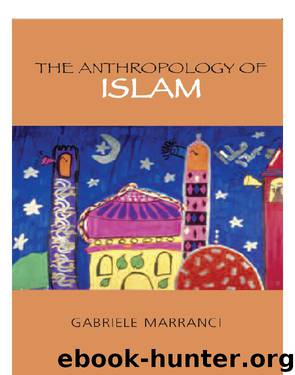The Anthropology of Islam by Marranci Gabriele;

Author:Marranci, Gabriele;
Language: eng
Format: epub
Publisher: Bloomsbury Publishing Plc
Published: 2008-03-01T05:00:00+00:00
CHAPTER 6
Beyond the Stereotype: Challenges in Understanding Muslim Identities
IDENTITY AND ANTHROPOLOGY
Identity has fascinated intellectuals, such as philosophers (e.g. Locke 1690/1959 and Hume 1740/1975), psychologists (e.g. James 1890) and sociologists (e.g.
Goffman 1959), for centuries. Each discipline, and within it each school and scholar, has provided an interpretation, theory and model. With them, they also provided terminologies that have proliferated into a confusing list. The frustration here is not with this excessive terminology per se, rather, by being used in different contexts and from different disciplines, it has lost its specification. So, ‘identity, ‘self-identity’, ‘personal identity, ‘self’, ‘selfhood’, ‘personhood’, ‘I’, ‘me’, ‘Me’ and a plethora of other terms (see Holland 1997) have confused more than clarified.
Sociologists have been exploring the relationship between self, identity and society since the beginning of the nineteenth century1 with pioneers such as Charles Horton Cooley (1909), George Herbert Mead (1934) and Herbert Blumer (1969).
By contrast, the first anthropologists did not show much interest in studying the ‘persona’; rather they concentrated their efforts on understanding the symbol, the object and the community seen as an expression of collective identity dictated by cultural processes. In one of the rare articles2 that analytically and critically discusses the study of identity in anthropology, Sökefeld (1999) has rightly observed that because of the overemphasis on society we have just discussed, anthropologists have denied the relevance that individuality and the personal self have in the study of the ‘others’.
He has suggested that social anthropologists took ‘Durkheim’s concept of “collective representations” . . . as justification for the fact that social anthropology gave little attention to the individual, regarding the social as its only object’ (1999: 428). According to Sökefeld, this has caused a serious flaw within the anthropological understanding of others’ selves,
This certainly applies to understandings of others’ selves. In the conceptualization of non-Western selves, the Western self was taken as the starting point and the non-Western self was accordingly characterized as its opposite: unbounded, not integrated, dependent, unable to set itself reflexively apart from others, unable to distinguish between the individual and a role or status that individual occupies, unable to pursue its own goals independently of the goals of a group or community. Effectively, this characterization involved the negation of all the definitional qualities of the self, that is, of those that point to the differentiation of the self from others. We can conclude, then, that by being denied a Western self, anthropology’s others were denied a self at all. (1999: 418)
Sökefeld concerns echo Cohen’s,
In the past, our concern with groups and categories, that is, with social bases of social relations, has largely ignored the dimensions of the self and self-consciousness, and may therefore be regarded as having dealt with bogus entities. In treating individuals either explicitly or by default as merely socially or culturally driven, ignoring the authorial or ‘self-driven’ aspects of behaviour, is to render them at best partial, and perhaps more often, as fictitious ciphers of the anthropologist’s theoretical invention. (1994: 7)
Indeed, he has reminded us how British
Download
This site does not store any files on its server. We only index and link to content provided by other sites. Please contact the content providers to delete copyright contents if any and email us, we'll remove relevant links or contents immediately.
The Vikings: Conquering England, France, and Ireland by Wernick Robert(79869)
Ali Pasha, Lion of Ioannina by Eugenia Russell & Eugenia Russell(40134)
The Conquerors (The Winning of America Series Book 3) by Eckert Allan W(37104)
The Vikings: Discoverers of a New World by Wernick Robert(36907)
Cecilia; Or, Memoirs of an Heiress — Volume 1 by Fanny Burney(32412)
Cecilia; Or, Memoirs of an Heiress — Volume 3 by Fanny Burney(31822)
Cecilia; Or, Memoirs of an Heiress — Volume 2 by Fanny Burney(31801)
Empire of the Sikhs by Patwant Singh(22962)
The Secret History by Donna Tartt(18805)
Hans Sturm: A Soldier's Odyssey on the Eastern Front by Gordon Williamson(18454)
Cat's cradle by Kurt Vonnegut(15152)
Pimp by Iceberg Slim(14318)
Sapiens: A Brief History of Humankind by Yuval Noah Harari(14210)
Talking to Strangers by Malcolm Gladwell(13185)
Norse Mythology by Gaiman Neil(13169)
Leonardo da Vinci by Walter Isaacson(13147)
4 3 2 1: A Novel by Paul Auster(12263)
Underground: A Human History of the Worlds Beneath Our Feet by Will Hunt(11997)
The Radium Girls by Kate Moore(11899)
